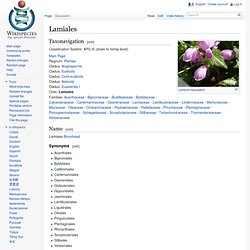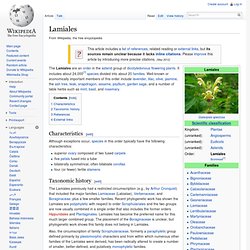

Oleaceae. Lentibulariaceae. Lamiaceae. Lamiales. Lamiales. [edit] Classification System: APG III (down to family level) Main Page Regnum: Plantae Cladus: Angiosperms Cladus: Eudicots Cladus: Core eudicots Cladus: Asterids Cladus: Euasterids I Ordo: Lamiales Familiae: Acanthaceae - Bignoniaceae - Buddlejaceae - Byblidaceae - Calceolariaceae - Carlemanniaceae - Gesneriaceae - Lamiaceae - Lentibulariaceae - Linderniaceae - Martyniaceae - Mazaceae - Oleaceae - Orobanchaceae - Paulowniaceae - Pedaliaceae - Phrymaceae - Plantaginaceae - Plocospermataceae - Schlegeliaceae - Scrophulariaceae - Stilbaceae - Tetrachondraceae - Thomandersiaceae - Verbenaceae Name[edit]

Lamiales. Characteristics[edit] Although exceptions occur, species in this order typically have the following characteristics: Taxonomic history[edit] The Lamiales previously had a restricted circumscription (e.g., by Arthur Cronquist) that included the major families Lamiaceae (Labiatae), Verbenaceae, and Boraginaceae, plus a few smaller families.

Recent phylogenetic work has shown the Lamiales are polyphyletic with respect to order Scrophulariales and the two groups are now usually combined in a single order that also includes the former orders Hippuridales and Plantaginales. Lamiales has become the preferred name for this much larger combined group. Lippenblütlerartige. Beschreibung[Bearbeiten] Die meist zwittrigen Blüten können vier- oder fünfzählig sein.

Meist sind nur zwei oder vier Staubblätter vorhanden.[1] Jede Blüte enthält meistens zwei, seltener bis zu fünf Fruchtblätter. Meist ist der Fruchtknoten durch falsche Scheidewände in vier Kammern unterteilt, die je eine Samenanlage enthalten.